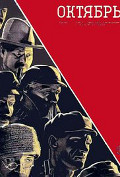
Directed by
Sergei Eisenstein
104 minutes
Rated PG
Reviewed by
Bernard Hemingway

October
Based on "Ten Days That Shook The World' (which is also an alternative title for the film), an eye witness account by American journalist John Reed (the subject of Warren Beatty's Reds, 1981), and commissioned by the Soviet Central Committee to commemorate the 10th anniversary of the 1917 October Revolution, this is the final edition of Eisenstein's "revolutionary" trilogy (the others being Battleship Potemkin, 1925, and Strike, 1924) and his last significant silent film.
Although essentially a propaganda film Eisenstein still had a considerable degree of creative freedom in keeping with the spirit of the times that were slowly coming to an end under Stalin (Lenin who is glorified here had died in 1924). Filmed on the actual locations, it is not only an ambitious reconstruction of the events of 1917 leading to the Bolshevik victory (Trotsky's role however is pointedly marginalised) but also manifests many of Eisenstein's ideas regarding film aesthetics, particularly his theory of montage, or ideographic imagery. Whilst the latter has tended to be justly criticised for its crude didacticism, there is no doubt that his camera work and editing techniques remain impressive, with the sequence involving the white horse and the raised bridge early in the film is an outstanding moment both in this film and cinema history.
Want something different?





